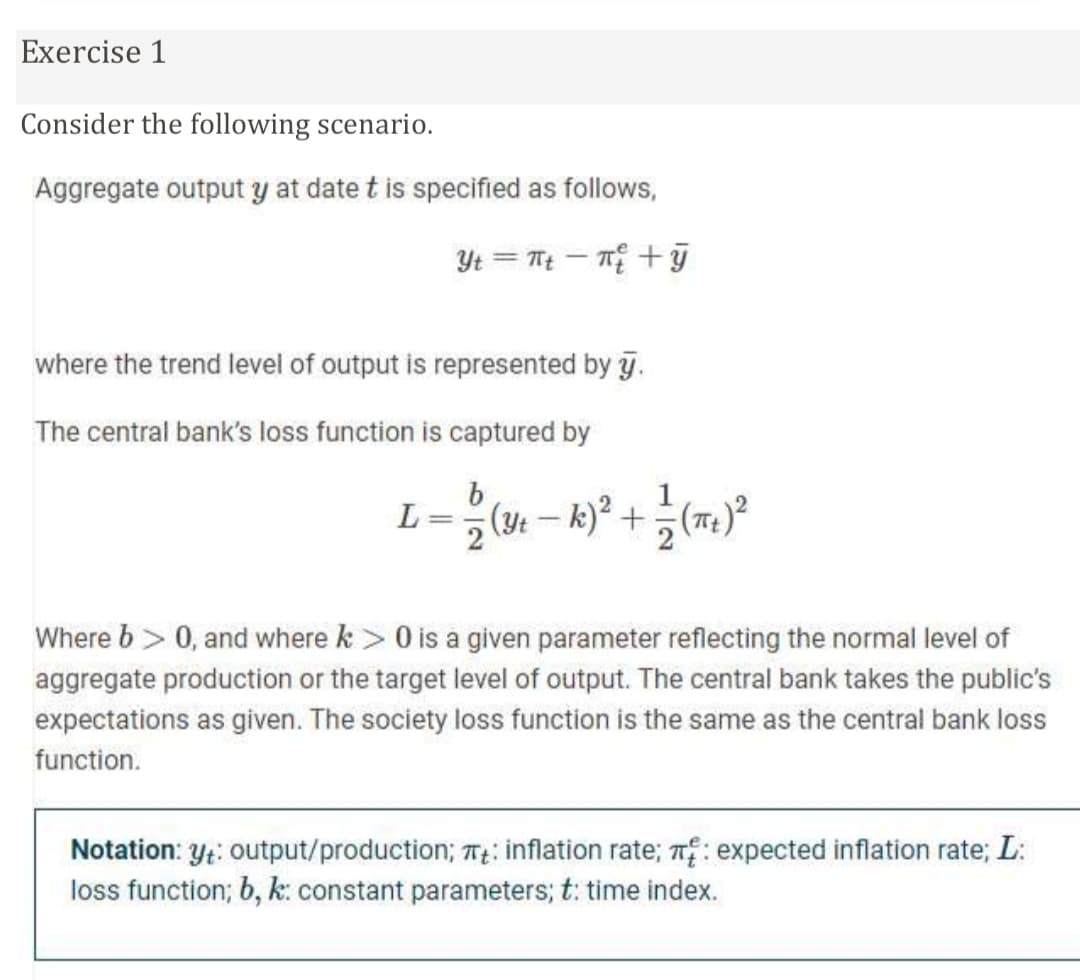Chapter1: Making Economics Decisions
Section: Chapter Questions
Problem 1QTC
Related questions
Question

Transcribed Image Text:Exercise 1
Consider the following scenario.
Aggregate output y at date t is specified as follows,
Yt = Tt – T +ỹ
where the trend level of output is represented by y.
The central bank's loss function is captured by
L
2
(y: – k)² +(T)
2
Where b> 0, and where k > 0 is a given parameter reflecting the normal level of
aggregate production or the target level of output. The central bank takes the public's
expectations as given. The society loss function is the same as the central bank loss
function.
Notation: y;: output/production; T: inflation rate; n: expected inflation rate; L:
loss function; b, k: constant parameters; t: time index.
![Exercise 2
Consider a modified aggregate supply function which takes account for the emergence of
random business cycle shocks (&t) with E&t] =O in the sense that
Yt = Tt – T + ÿ +&t
The loss function is the same as in exercise 1:
(yt – k)? +(72)?
Notation: Et: random shock; E[e,]: expected value of €t; b: constant parameter; all
other variables see Exercise 1.
Having considered the scenario above complete the following tasks:
a) Derive the central bank's preferred inflation rate and explain.
b) The result in a) reads as
b(k – 9) – H5
ɛb
Explain the economic intuition of this result.
c) Consider a more conservative central banker whose loss
function is represented by
L = (4 – k)² + } (Tt)²
Apparently, the preferred inflation rate would read
6(k – 9) –
||
1+ô
What can you say about the relationship between ô and b? Is i
larger or smaller than b? Provide an explanation.
d) Given the above output function and y
Yt = Tt – T +€4, the inflation rate and the loss-function in c), it
can be shown that the loss function can be expressed as a
:0, such that
||
function of b
z (1) – }{* (* » +) + 1}
():
3),
2 (6² + ô) + E [=*]}
(1+8')
Assuming that L represents the social welfare function, the
socially optimal level of conservatism b can be obtained from the
first-order condition of L(ô) with respect to 6. Show from this
condition whether b is larger or smaller than b.](/v2/_next/image?url=https%3A%2F%2Fcontent.bartleby.com%2Fqna-images%2Fquestion%2Ffc2282c0-845a-481e-b6d9-8632187a46fc%2Feff476f1-7806-4a3b-a85e-4dc4c33e87b6%2Fkt78l4_processed.jpeg&w=3840&q=75)
Transcribed Image Text:Exercise 2
Consider a modified aggregate supply function which takes account for the emergence of
random business cycle shocks (&t) with E&t] =O in the sense that
Yt = Tt – T + ÿ +&t
The loss function is the same as in exercise 1:
(yt – k)? +(72)?
Notation: Et: random shock; E[e,]: expected value of €t; b: constant parameter; all
other variables see Exercise 1.
Having considered the scenario above complete the following tasks:
a) Derive the central bank's preferred inflation rate and explain.
b) The result in a) reads as
b(k – 9) – H5
ɛb
Explain the economic intuition of this result.
c) Consider a more conservative central banker whose loss
function is represented by
L = (4 – k)² + } (Tt)²
Apparently, the preferred inflation rate would read
6(k – 9) –
||
1+ô
What can you say about the relationship between ô and b? Is i
larger or smaller than b? Provide an explanation.
d) Given the above output function and y
Yt = Tt – T +€4, the inflation rate and the loss-function in c), it
can be shown that the loss function can be expressed as a
:0, such that
||
function of b
z (1) – }{* (* » +) + 1}
():
3),
2 (6² + ô) + E [=*]}
(1+8')
Assuming that L represents the social welfare function, the
socially optimal level of conservatism b can be obtained from the
first-order condition of L(ô) with respect to 6. Show from this
condition whether b is larger or smaller than b.
Expert Solution
This question has been solved!
Explore an expertly crafted, step-by-step solution for a thorough understanding of key concepts.
This is a popular solution!
Trending now
This is a popular solution!
Step by step
Solved in 4 steps

Knowledge Booster
Learn more about
Need a deep-dive on the concept behind this application? Look no further. Learn more about this topic, economics and related others by exploring similar questions and additional content below.Recommended textbooks for you


Principles of Economics (12th Edition)
Economics
ISBN:
9780134078779
Author:
Karl E. Case, Ray C. Fair, Sharon E. Oster
Publisher:
PEARSON

Engineering Economy (17th Edition)
Economics
ISBN:
9780134870069
Author:
William G. Sullivan, Elin M. Wicks, C. Patrick Koelling
Publisher:
PEARSON


Principles of Economics (12th Edition)
Economics
ISBN:
9780134078779
Author:
Karl E. Case, Ray C. Fair, Sharon E. Oster
Publisher:
PEARSON

Engineering Economy (17th Edition)
Economics
ISBN:
9780134870069
Author:
William G. Sullivan, Elin M. Wicks, C. Patrick Koelling
Publisher:
PEARSON

Principles of Economics (MindTap Course List)
Economics
ISBN:
9781305585126
Author:
N. Gregory Mankiw
Publisher:
Cengage Learning

Managerial Economics: A Problem Solving Approach
Economics
ISBN:
9781337106665
Author:
Luke M. Froeb, Brian T. McCann, Michael R. Ward, Mike Shor
Publisher:
Cengage Learning

Managerial Economics & Business Strategy (Mcgraw-…
Economics
ISBN:
9781259290619
Author:
Michael Baye, Jeff Prince
Publisher:
McGraw-Hill Education